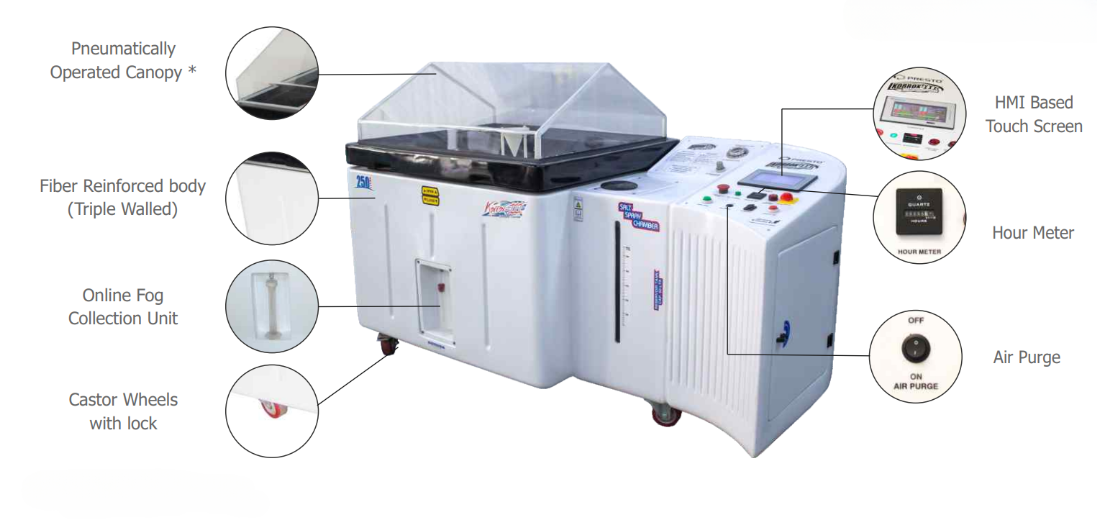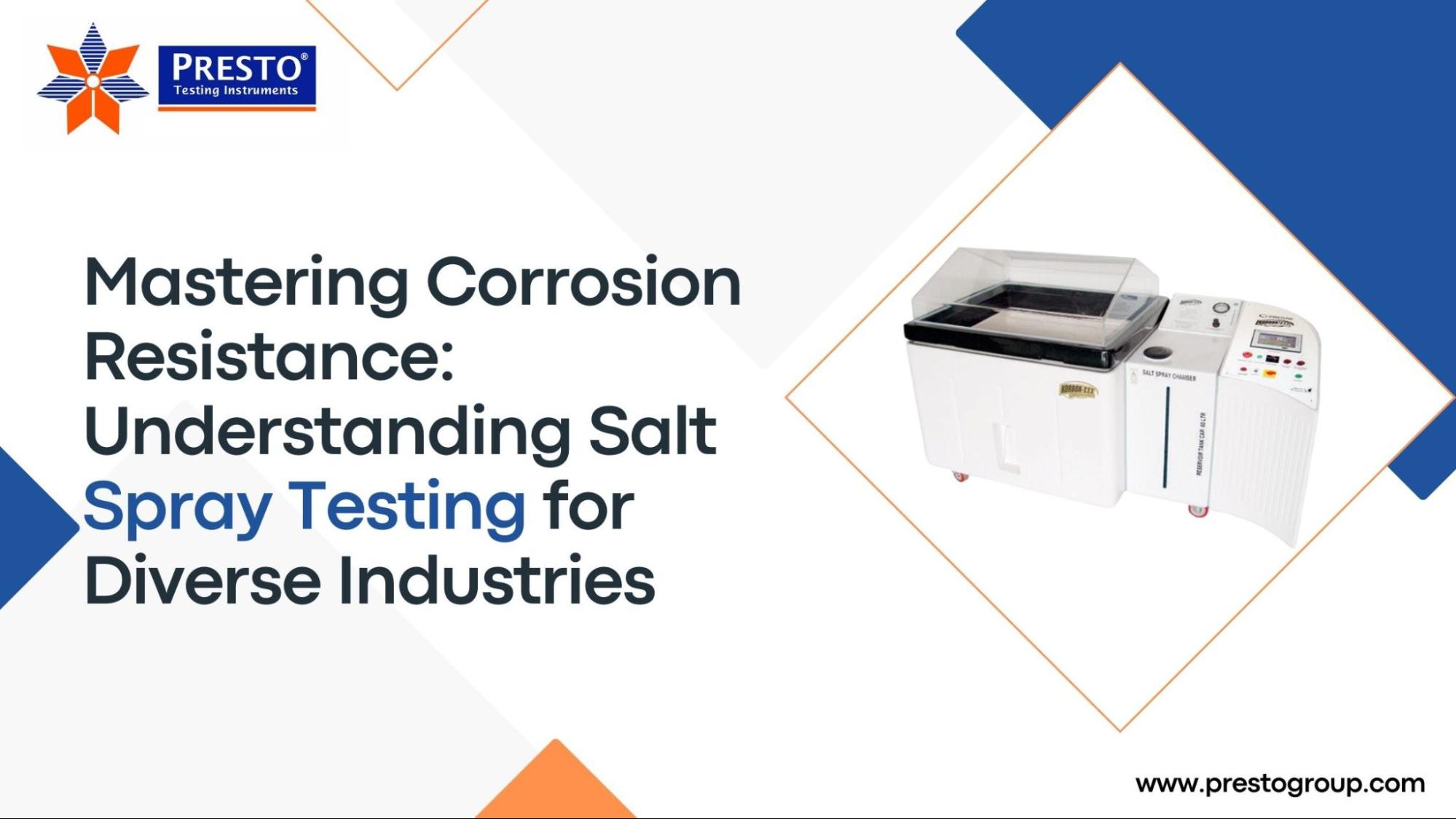Salt spray chamber working
Salt spray testing is a controlled corrosion test done using a salt fog chamber. The test is for the durability of materials and coatings, exposing the items to a very corrosive atmosphere laced with salts, simulating accelerated corrosive conditions that can give insight into the material's performance under real exposure.
The main goal is to know how long the protective coating, either galvanizing or painting, will last and at what point will corrosion start showing up, which can be identified by red rust Fe?O? or white rust Zn(OH)?. Manufacturers take these results to their advantage and mould their materials and coatings to give long-term durability.
Salt Spray Chamber
A SST chamber produces an aerosol mist of saline solution, usually comprising sodium chloride in a controlled condition. The testing procedure is divided into the following steps:
-
Samples Preparation: The materials taken are galvanized, coated, electroplated, or uncoated.
-
Solution of Salt: A standard solution is prepared often 5% sodium chloride solution to ensure homogeneity.
-
Ambient within the Chamber: The chamber maintains a controlled temperature and humidity level to imitate extreme weather conditions.
-
Observation: Samples have periodic inspections for the appearance of red rust or white rust.
Pre-testing period may be hours or even weeks depending on the standards of the industry and the requirements of customers.
 Salt Spray Testing Applications
Salt Spray Testing Applications
Salt spray testing is now a common element in several industries.
1.Automotive Industry
Body Panels and Fasteners: The Electroplated finishes and coatings are checked for corrosion resistance.
Critical Components: For high-moisture environments, structural integrity must be ensured.
2. Marine Industry
Ship Hardware: Reliability of bolt, anchor, and hinge durability in high-salt environments.
Anticorrosion Coatings: Protecting against seawater corrosion for long life-span.
3. Electronics Industry
PCBs and Connectors: Determination of electronic components exposed to moisture for long service life
Protective Coatings: Layers of coatings on the connector are evaluated for maintaining electrical circuit performance
Regulations Related to Salt Spray Tester or Corrosion tester
To be uniform and trustworthy, salt spray testing follows all recognized international standards:
-
ASTM B117: The most commonly utilized reference standard of neutral salt spray testing.
-
JIS Z 2371: Salt spray testing for industrial products of Japanese origin.
-
ISO 9227: International standard focusing on neutral, acetic acid, and copper-accelerated salt spray tests.
These reference standards define test procedures, equipment specifications, and acceptable corrosion levels for specified applications, hence providing consistent benchmarks across industries.
Why Salt Spray Testing?
Salt spray testing has many benefits:
-
Predictive Analysis: Points out locations that are prone to corrosion, and preventative measures can be undertaken.
-
Material Validation: This entails fulfilling durability requirements.
-
Quality of Products: Allows for refining protective coatings so they would be resistant even in stressful conditions.
-
Cost Effectiveness: Indicates weaknesses are detected before product failures at field levels which are very costly.
Key Findings Regarding Corrosion Behaviour
Deterioration observed in tests
include the following:
Red Rust (Fe?O?): represents the destruction of steel or iron's protective layers.
White Rust (Zn(OH)?): Indicates degradation of zinc-based paints.
These tests prove the attacking nature of chloride ions, which break the metal oxide bond created during passivation. This data is essential for manufacturers who are trying to extend the life of materials.
Salt Spray Equipment for Experts
Quality corrosion testing equipment is essential for reliable results. In choosing a salt spray chamber to buy, consider the following:
-
Chamber Size: Adequate space for accommodating different dimensions of samples.
-
Compliance: Conformity to ASTM, JIS, or ISO standards.
-
Ease of Operation: Controls are simple and user-friendly. Automation capabilities can be installed to automatically run through cycles.
Corrosion-resistance of materials within the salt spray equipment.
In addition, the modern equipment offers real-time monitoring, logging, and programmable test cycles so it can better accommodate specific test requirements.
 FAQs
FAQs
1. How long is a salt spray test?
The length of time varies based on the type of material and coating under evaluation. Some can last for 24 hours, and others may last several weeks to provide exposure to a long time.
2. What are the types of materials that can be tested?
Salt spray testing is ideally used for metals, electroplated surfaces, galvanized materials, and coated components.
3. What is the difference between neutral, copper-accelerated, and acetic acid salt spray tests?
Neutral Salt Spray (NSS): It uses a saline solution with a neutral pH.
Copper-Accelerated Salt Spray (CASS): This uses copper ions for aggressive testing and is suitable for decorative coatings.
Acetic Acid Salt Spray (AASS): Acetic acid is used to create an acidic atmosphere.
4. Can salt spray chambers simulate field conditions?
Accelerated test. Provides an idea about failure points. Real-world conditions will have UV exposure or temperature fluctuations.
For professionals seeking a salt spray chamber for sale, the right equipment tailored to specific needs is important. With the advancement of salt spray equipment, industries now have access to cutting-edge solutions for mastering corrosion resistance effectively.
Phone: +91-9210 903 903
Mail: info@prestogroup.com
